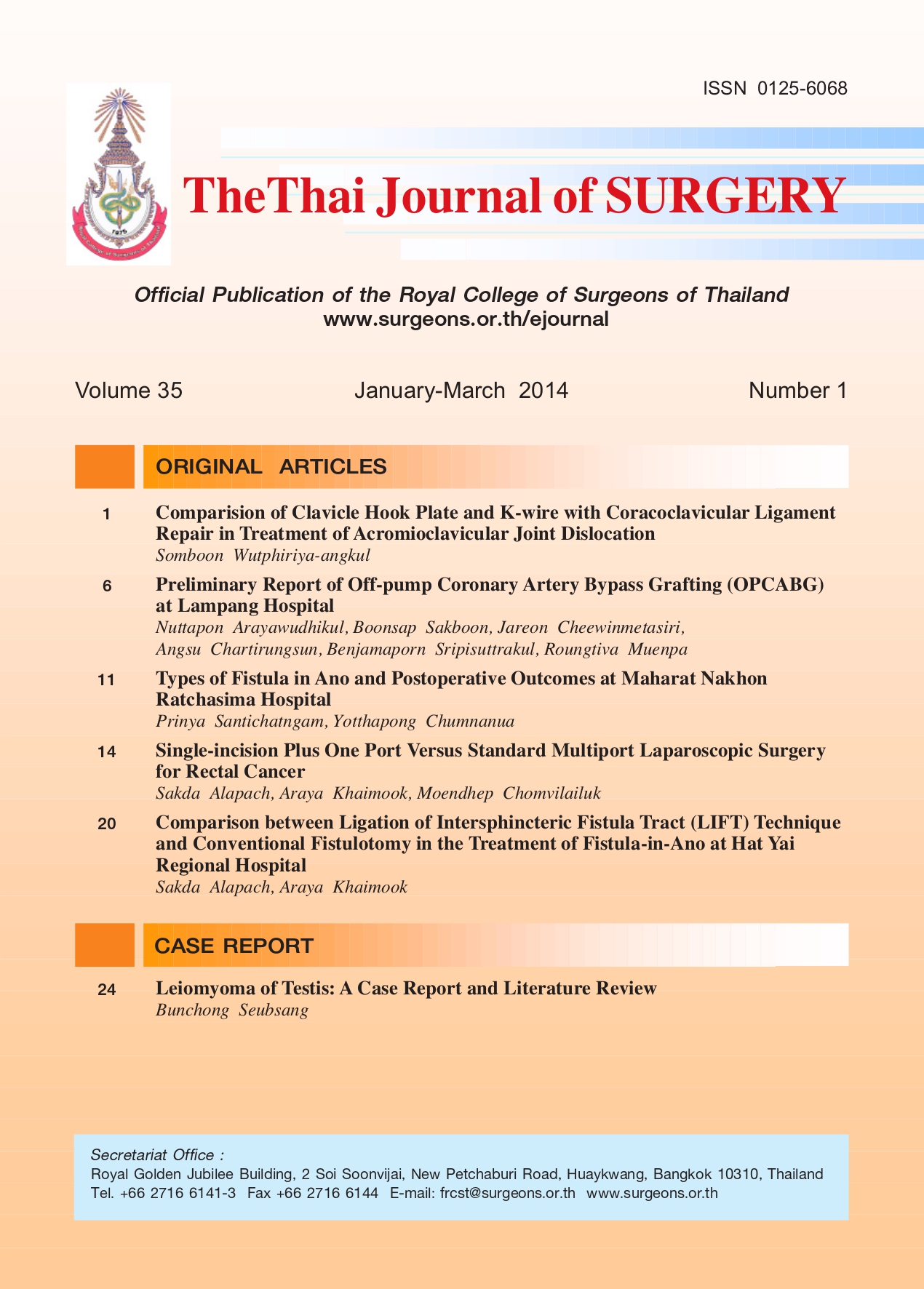Comparision of Clavicle Hook Plate and K-wire with Coracoclavicular Ligament Repair in Treatment of Acromioclavicular Joint Dislocation
Keywords:
Acromioclavicular joint dislocation, Clavicle hook-plate, K-wire fixation, Coracoclavicular ligament repairAbstract
Background and objectives: The most effective method for the surgical treatment of acromioclavicular joint dislocation has not been established. Two commonly used techniques are clavicle hook-plate fixation and K-wire fixation with coracoclavicular ligament repair. We performed a retrospective study to compare these two treatment strategies.
Materials and Methods: A total of 60 patients were selected for review. Each patient was treated by one of the two methods. Data including operative time, pain score, shoulder score, return to previous work within three months, return to previous activity within six months, and operative complications were collected.
Results: Thirty-two patients were treated with clavicle hook plate fixation, and the rest (28) were treated with K-wire fixation and coracoclavicular ligament repair. Clavicle hook-plate fixation was associated with significantly shorter operative time and lower rate of complications (P < 0.05). There were no significant differences in postoperative pain, shoulder score, return to previous work within three months, and return to previous activity within six months, between the two groups.
Conclusion: The clavicle hook-plate technique is similar in effectiveness to the K-wire fixation with coracoclavicular ligament repair in the treatment of acromioclavicular joint dislocation, but with shorter operative time and fewer complications.
References
2. Prokop A. et al. [Tossy III injuries of the acromioclavicular joint. In what circumstances is surgery still justified? Personal results and literature review] Orthopade 2003;32:432–6.
3. Kiefer H, Claes I, Burri C, et al. The stabilizing effect of various implants on the torn acromioclavicular joint. A biomechanical study. Arch Orthop Trauma Surg 1986; 106:42–6.
4. Kashii M, Inui H, Yamamoto K. Surgical treatment of distal clavicle fractures using the clavicular hook plate. Clin Orthop 2006;447:158–64.
5. Lancaster S, Horowitz M, Alonso J. Complete acromioclavicular separations. A comparison of operative methods. Clin Orthop Relat Res 1987;216:80–8.
6. Constant CR, Murley AHG. A clinical method of functional assessment of the shoulder. Clin Orthop 1987;214:160–4.
7. Rehn J, Thelen E. [Injuries of the acromioclavicular joint] Hefte Unfallheilkd. 1975;126:131–6.
8. Nuber GW, Bowen MK. Acromioclavicular joint injuries and distal clavicle fractures. J Am Acad Orthop Surg 1997;5:11–8.
9. Gstettner C. et al. Rockwood type III acromioclavicular dislocation: surgical versus conservative treatment. JShoulder Elbow Surg 2008;17:220–5.
10. Broos P, et al. [Surgical management of complete Tossy III acromioclavicular joint dislocation with the Bosworth screw or the Wolter plate. A critical evaluation] Unfallchirurgie 1997;23:153–9.
11. Larsen E, Bjerg-Nielsen A, Christensen P. Conservative or surgical treatment of acromioclavicular dislocation. A prospective, controlled, randomized study. J Bone Joint Surg Am 1986;68:552–5.
12. Galpin RD, Hawkins RJ, Grainger RW. A comparative analysis of operative versus nonoperative treatment of grade III acromioclavicular separations. Clin Orthop Relat Res 1985;193:150–5.
13. Ejam S, Lind T, Falkenberg B. Surgical treatment of acute and chronic acromioclavicular dislocation Tossy type III and V using the hook plate. Acta Orthop Belg 2008;74:441–5.
14. Salzmann GM, et al. Arthroscopic anatomical reconstruction of the acromioclavicular joint. Acta Orthop Belg 2008; 74:397–400.
15. Kienast B, Thietje R, Queitsch C, Gille J, Schulz AP, Meiners J. Mid-term results after operative treatment of rockwood grade III-V acromioclavicular joint dislocations with an AChook- plate. Eur J Med Res 2011;16:52-6.
16. De Baets T, Truijen J, Driesen R, Pittevils T. The treatment of acromioclavicular joint dislocation Tossy grade III with a clavicle hook plate. Acta Orthop Belg 2004;70:515-9
Downloads
Published
How to Cite
Issue
Section
License
Articles must be contributed solely to The Thai Journal of Surgery and when published become the property of the Royal College of Surgeons of Thailand. The Royal College of Surgeons of Thailand reserves copyright on all published materials and such materials may not be reproduced in any form without the written permission.



